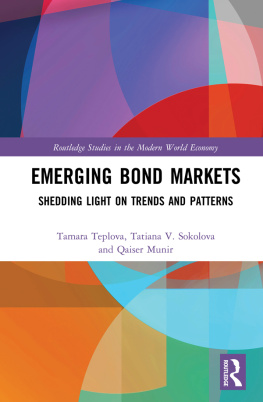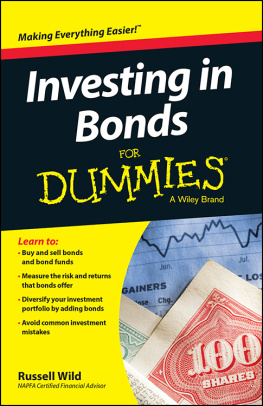The Bond Markets of Developing East Asia
The Bond Markets of Developing East Asia
Robert F. Emery
First published 1998 by Westview Press
Published 2018 by Routledge
711 Third Avenue, New York, NY 10017, USA
2 Park Square, Milton Park, Abingdon, Oxon OX14 4RN
Routledge is an imprint of the Taylor & Francis Group, an informa business
Copyright 1998 by Taylor & Francis
All rights reserved. No part of this book may be reprinted or reproduced or utilised in any form or by any electronic, mechanical, or other means, now known or hereafter invented, including photocopying and recording, or in any information storage or retrieval system, without permission in writing from the publishers.
Notice:
Product or corporate names may be trademarks or registered trademarks, and are used only for identification and explanation without intent to infringe.
Library of Congress Cataloging-in-Publication Data
Emery, Robert F. (Robert Firestone), 1927
The bond markets of developing East Asia / Robert F. Emery.
p. cm.
Includes bibliographical references and index.
ISBN 0-8133-2969-8 (hc.)
1. Bond marketEast Asia. I. Title.
HG5770.5.A5E46 1997
332.63'23'095dc20 96-43120
CIP
ISBN 13: 978-0-8133-3633-6 (pbk)
To Phyllis and Ross in appreciation for their help
Several factors have contributed to my interest in writing this book on the bond markets of developing East Asia. Foremost is the rapid growth and rising importance since the early 1990s of the bond markets in these economies. I was also encouraged by the successful reception of my earlier book, The Money Markets of Developing East Asia , published in 1991.
My basic objective in writing this book has been to provide as much useful and practical information as possible on the eight bond markets covered in the book. An additional objective has been to provide an in-depth analysis of each bond market along with various suggestions for improvement of the market. I hope that these suggestions will assist government officials and business leaders in these economies as they pursue their goals of developing and improving the domestic bond markets. The last chapter discusses, among other things, the lessons that can be learned from the experiences of these countries in developing their bond markets and describes the basic ingredients for developing a viable and growing bond market.
Much of the material in the book is based on personal contacts with individuals and institutions as a result of an extensive field trip to the eight economies covered in the book. I also benefited from receiving comments and recent data from most of the central banks in the region, especially end-of-1995 data on the size of the bond markets.
In that regard I would like to express my deep appreciation to the following institutions that have been very helpful in the preparation of this book: Hong Kong Monetary Authority, Bank Indonesia, Bank of Korea, Bank Negara Malaysia, Bangko Sentral ng Pilipinas , Central Bank of China, and Bank of Thailand. I also received helpful comments from Steven Kwiatkowski, President, Springfield Investment Advisory (Taipei).
Each of the country chapters contains a list of acronyms and abbreviations, as well as a substantial number of endnotes. Although I have attempted to make the book as accurate and up-to-date as possible, some information may not be correct, as is likely with any book of this type containing a great deal of factual information. Hence, readers are advised to check further before any important actions with possibly adverse financial implications are undertaken.
Robert F. Emery
This study of the bond markets of developing East Asia has several objectives. The first is to provide as much relevant information as possible on the bond markets in these countries, including details on the main participants, types of bonds issued, size of the markets, and methods of operation. The second objective is to discover what lessons can be learned from an examination of these bond markets. Which of the systems have been effective and which have not? Have the government's policies for the bond market been appropriate? An assessment is made of each bond market's past performance, and measures are suggested to improve the market. The third objective is to assess the extent of the growth and development of each of the eight bond markets. Data are provided on the size of each country's domestic bond market, and cross-country comparisons are made in the last chapter, which also explains the benefits that a country can receive from an active and viable bond market.
Since the late 1980s most of the bond markets in these eight countries have grown substantially. Some of the important factors that have contributed to this growth include the liberalization of financial controls, the influx of foreign capital, the growth of institutional investors, and the establishment of domestic credit rating agencies. In addition, with the region's large needs for economic infrastructure, many state enterprises are expanding their issues of bonds. The growing appeal of fixed-income securities and unit trusts that invest in bonds has also contributed to the rapid growth of the bond markets in the region. The establishment in late 1991 of the Dragon bond market has also spurred the listing of bonds on the Hong Kong and Singapore stock exchanges.
Although the stock exchanges in these eight countries provide a facility for listing many of these new bond issues, the main trading of the bonds in the region does not take place on the stock exchanges. Most of the trading in the secondary market occurs in the over-the-counter market, and in many of these countries the secondary market in bonds is not very active.
Scope of the Study
The focus of this study is on debt instruments, mainly bonds, with a maturity of one year or more. It does not cover the two other main components of a capital market, equity shares and mortgage debt, or a money market. The selection of a one-year cutoff period is admittedly arbitrary, but it has also been the way traditionally to distinguish a bond market from a money market. Hence, the stated maturity for a debt instrument is a key distinguishing element.
In general, a bond is a debt instrument that normally pays a fixed amount of interest periodically and the principal or face value of the bond at maturity. Some exceptions to this general definition would be zero coupon bonds, also known as discount bonds, that do not pay interest periodically, and consols, which have no stated maturity. The interest paid on floating-rate bonds varies, but the amount is fixed in relation to some changing index.
The study examines all types of bonds, including straight bonds, debentures, convertible bonds, and bonds with warrants. The focus of the study is on the domestic bond market, but international bonds listed in Hong Kong and Singapore are so predominant that data and analysis on those bonds are also included in the study. In addition to investigating both the primary and secondary components of the bond market, the study examines bond activity on the stock exchange, on the over-the-counter market, and any third anternatives.
For the sake of convenience, the study usually does not distinguish between bonds and notes but refers to both as bonds. Hence, unless specifically indicated, the book will generally use the term "bonds" for "bonds and notes."










